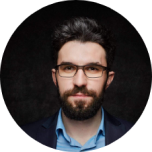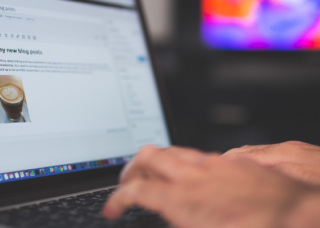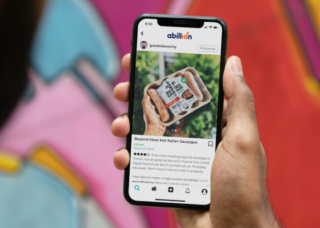 Archiwum prywatne
Archiwum prywatne How to cope in a world you can’t see?
- Przejdź do artykułów z tagiem accessibility
- Przejdź do artykułów z tagiem Web Content Accessibility Guidelines
Article content
Łukasz Stanik – Accessibility Specialist at Kinaole
An avid gamer, Matrix fan, lover of honey sandwiches, diver, railway enthusiast, keen observer of reality, altruist, person with great empathy, distance to oneself and the world, with countless anecdotes about the life of a blind person, which he has been since early childhood.
A: Hi, Łukasz. Thank you for agreeing to share about yourself in this interview.
Ł: Hi! Thank you as well. I hope I can offer some insight into my perspective for anyone interested.
A: To start, where do you currently live?
Ł: I live in Bydgoszcz.
A: Could you tell us more about your background? Why Bydgoszcz? I understand you were born elsewhere.
Ł: I was born in Silesia. I’ve been living in Bydgoszcz for 7 years now. I was brought here by a love story, but maybe I’ll talk about that another time (laughs). I’m 29 years old now. I haven’t always been blind, although I don’t remember much from the time when I had functional eyesight.
A: Could you tell us more about that?
Ł: I was born four months premature, so I was placed in an incubator. Due to retinopathy of prematurity, my eyesight was severely damaged. I couldn’t see out of one eye, and the condition of the other deteriorated rapidly. I underwent several surgeries aimed at preserving partial vision. Unfortunately, they weren’t successful. Today, I can only perceive a little light, and even that depends on my psychophysical condition.
A: What do you do? What’s your situation like now?
Ł: Currently, I work as a digital accessibility specialist at Kinaole. I’ve been collaborating with Piotr for some time, but since April this year, I’ve been working full-time. My main task is to support the Accessibility department in their daily duties. I also test digital products for accessibility. I share the perspective of a blind person with the team during audits. Together with Piotr, we also conduct educational training on accessibility.
A: What does training led by a blind person look like?
Ł: I tell able-bodied people how I manage in daily life. I explain how I perform everyday tasks. These tasks may seem trivial, but they can be very difficult for people with disabilities. This allows ordinary people to put themselves in my shoes. I talk about systemic or tool-related limitations. I also present examples of adapting everyday objects for blind people. There’s a thermometer that vocally informs about body temperature. There’s also a sensor for measuring the amount of liquid poured into a glass. There’s a tool called ColorTest, which enables color selection for clothes. I also talk about using Braille alphabet. There’s also an app for recognizing banknotes or barcodes.
A: Which tools and technologies do you think have evolved the most and make your daily life easier?
Ł: The simplest example would be a regular mobile phone. 30 years ago, nobody suspected that blind people would be able to use them. In 1998, Symbian and Talks systems were created, allowing dialing numbers from the contact list, as well as reading the screen or SMS messages. However, it was an expensive and hard-to-reach program.
Computers also made a huge technological leap. The first program helping people with vision problems use a computer was JAWS. It was the first so-called “Screen reader,” a program for reading the screen. Later came smartphones. The iPhone helped me a lot, specifically the 3GS model. It had technology supporting blind people. It had only 4 buttons, with the main one serving many functions. I remember vividly the consternation in the world of blind people. Nobody could imagine how you could use a touchscreen without any buttons. There was a lot of curiosity. Many Polish iPhone stores allowed disabled people to test smartphones. It was a huge breakthrough. Despite the high price of the phone, the device was very attractive and did not require additional software like Symbian.
A: What does using a smartphone look like in practice? Could you tell us about it?
Ł: Today, smartphones respond to voice commands. Operating a touchscreen for blind people is a bit different than for sighted people. My interaction with the smartphone involves what’s called flicking. I move my finger across the screen, and VoiceOver tells me which tiles I’m hovering over. I enter a specific function by double-clicking anywhere on the screen.
A: Is there anything difficult or hindering for the user in assistive technology?
Ł: There’s nothing inherently wrong with the technology itself. The problem lies in its improper application. I’ll explain this with a very simple example, like the touchscreen panel in elevators. Elevators used to have regular buttons. Over time, they were replaced with a touchscreen panel. We don’t have the ability to press the right button. Without proper support, we have to press the required field with a number precisely. It’s absurd because the panel is completely smooth, and we can’t find it. There were comical situations where we clicked on the touchscreen randomly. The floor we landed on was always a surprise.
I’ve heard of cases where installers were supposed to apply Braille overlays on the control panel when installing elevators in buildings. However, they didn’t receive instructions on how to apply them correctly. Sometimes the overlays were thrown away.
A: How can this system be improved to prevent such situations?
Ł: Companies are not aware of the needs of people with disabilities, not only physical but also visual impairments. Disability is primarily associated with wheelchairs or crutches. However, there’s a much wider spectrum of disabilities, and the needs are also broad.
A: We already know a bit about the difficulties in daily life. What problems do you encounter in the digital world?
Ł: There are plenty of examples, but there isn’t enough time to tell everything. The first difficulty that comes to mind is the authentication system CAPTCHA. Searching for similar elements like a bike or a car is easy for sighted people. For the blind, it’s impossible. Someone improved the system for people with disabilities. They added an audio recording that can be played back. In my opinion, however, it doesn’t fulfill its role. The recordings are often of poor quality. Sometimes they are in English or German. The audio prompt doesn’t always want to play.
Another example is Jakdojade. It’s an application that allows you to check how to get from point A to point B using public transportation. It displays timetables, but the announcements about the hours are convoluted, and I have trouble understanding them.
A positive example is the food ordering app, Pyszne.pl. It used to crash when VoiceOver was launched. Today, I can simply order takeaway food from any restaurant in this app. It’s nice that someone came up with the idea that disabled people also eat (laughs).
Another topic is the world of computer games. I’m a big fan of gaming, but usually, the games are not accessible. Exceptions are Dice World and Sonar Islands, which I play on my smartphone. If I could regain my sight for just one day, my dream would be to improve inaccessible computer games. Although I have no idea how to do it. Maybe I could learn or share my perspective with game developers.
It’s a great pity that the needs of blind people are not taken into account in this world. Who said that the visual content in the game is necessary? There’s narration, music, action. We can find ourselves in the real world without the sense of sight. Why wouldn’t we find ourselves in the virtual world, sitting safely in a chair?
A: Thanks for the examples. I’ll ask one last question. In which sectors of the digital world do you see potential for change in the context of adaptation for disabled people?
Ł: I’ll give a very mundane, simplest example. It’s about the possibility of sending, reading, and signing contracts or bank documents online. When I have to sign a paper contract, I need someone sighted with me. I need help reading the document. I need to know where to sign and how to correctly fill out the form. I need to pass all my data to another person, so it has to be someone trusted. I hope you understand the broader context of this problem. I have many blind friends and acquaintances. Not all of them are as independent and determined as I am. How are we supposed to not think about our disability when we need healthy people to help us with basic everyday tasks? Wouldn’t it be easier to create accessible PDFs that I could fill out and send to a designated email?
A: Thank you for this interview.
Interview conducted by Anna Krasna
Proofreading: Sara Pasek

Piotr Zrolka
Accessibility expert & CEO
Recommended articles
-
 14.03.2023UX / UI
14.03.2023UX / UIHow to write in plain language?
Not without reason, plain language is an integral part of UX writing. Are you creating content for your website, writing…
-
 19.02.2023Accessibility
19.02.2023AccessibilityWCAG 2.1 – Criterion 1.2.6 – Sign Language (Level AAA)
Today, we focus on another accessibility criterion – 1.2.6 – sign language (Level AAA). Do you remember the recent awards…
-
 14.01.2023Accessibility
14.01.2023AccessibilityWCAG 2.1 – Criterion 1.1.1 – Text Alternatives (Level A)
New year – new step! We’re starting a weekly Friday series “Understanding Digital Accessibility Based on WCAG 2.1”. WCAG is…
